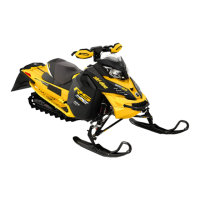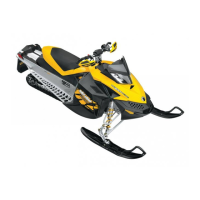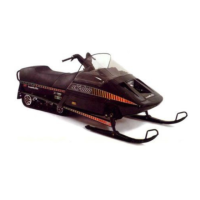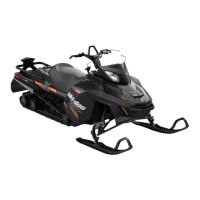Do you have a question about the Ski-Doo MX Zx 600 RS and is the answer not in the manual?
Essential pre-ride knowledge for safe operation.
Understanding warning symbols and their meaning.
Purpose, terminology, and structure of the operator's guide.
Important safety rules to prevent hazards like CO poisoning and fires.
Critical warnings for severe injury or death during operation.
Guidelines for safe operation, pre-ride checks, and riding techniques.
Information on studs and carbide runners affecting handling.
Identification and location of safety labels on the vehicle.
Details about vehicle components and identification numbers.
Controls steering by turning the skis.
Controls engine speed and transmission engagement.
Applies the brake, proportional to pressure.
Engages parking brake for securing the vehicle.
Shuts off engine if operator falls off.
Stops engine in emergency situations.
Injects fuel for cold engine starts.
Manual method for starting the engine.
For racing application, pre-heats tuned pipe.
Selects headlamp beam intensity.
Adjusts hand and thumb temperature.
Displays speed, RPM, messages, and fault codes.
Allows removal of seat for access to guide or maintenance.
Used for lifting the snowmobile.
Protects moving parts, must be installed.
Never operate engine with hood removed.
Never operate engine with side panels removed.
Specifies fuel type and octane rating.
Steps for safely refueling the vehicle.
Specifies oil type and mix ratio.
Examples of correct fuel/oil mixing.
Guidelines for initial vehicle operation and inspection.
Break-in procedures for the engine.
Break-in requirements for the drive belt.
Step-by-step guide for starting the engine.
Recommended steps for warming up the vehicle before riding.
Procedure for safely stopping the engine.
Vehicle calibration for altitude.
Operating limits and calibration for temperature.
Riding advice for hard packed snow and ice.
Safe procedures for towing a disabled snowmobile.
Using an emergency starter rope to start the engine.
How suspension affects handling and comfort.
Adjusting rear springs and components.
Adjusting center spring for steering and handling.
Adjusting stopper strap for performance.
Adjusting low/high speed compression damping.
Adjusting front springs and shocks.
Corrective measures for handling issues.
Safe practices for transporting the snowmobile.
Required inspection after initial use.
Routine service intervals and tasks.
Detailed instructions for maintenance tasks.
Resetting the TPS sensor.
Verifying air filter condition.
Checking and maintaining coolant level.
Verifying exhaust system condition.
Inspecting and replacing spark plugs.
Adjusting the engine stopper.
Recommended fluid and checking level.
Recommended oil and checking level.
Inspection, replacement, and installation.
Drive pulley adjustment for RPM.
Inspecting track for wear and damage.
Inspection for studded tracks.
Procedures for checking and adjusting track.
Cleaning after use and storage tips.
Methods for cleaning and protecting surfaces.
Location of the vehicle description decal.
Locating VIN and engine serial numbers.
Understanding VIN structure and location.
Location of the engine serial number.
Who can perform emission control maintenance.
Manufacturer and dealer responsibilities for emissions.
Manufacturer's role in emissions certification.
Dealer's role in maintaining emissions standards.
Owner's role in maintaining emission levels.
Information on EPA regulations for emissions.
Troubleshooting steps for engine starting issues.
Troubleshooting steps for lack of engine power.
Troubleshooting steps for engine backfires.
Troubleshooting steps for engine misfires.
Understanding dashboard indicator lights and codes.
Reading and interpreting fault codes.
Defines what the warranty covers.
Outlines warranty limitations and exclusions.
Lists items not covered by the warranty.
Duration of warranty coverage.
Requirements for warranty coverage eligibility.
Defines warranty scope for specific regions.
Outlines warranty limitations and exclusions for specific regions.
Lists items not covered by warranty for specific regions.
Duration of warranty coverage for specific regions.
Requirements for warranty coverage eligibility for specific regions.
Essential pre-ride knowledge for safe operation.
Understanding warning symbols and their meaning.
Purpose, terminology, and structure of the operator's guide.
Important safety rules to prevent hazards like CO poisoning and fires.
Critical warnings for severe injury or death during operation.
Guidelines for safe operation, pre-ride checks, and riding techniques.
Information on studs and carbide runners affecting handling.
Identification and location of safety labels on the vehicle.
Details about vehicle components and identification numbers.
Controls steering by turning the skis.
Controls engine speed and transmission engagement.
Applies the brake, proportional to pressure.
Engages parking brake for securing the vehicle.
Shuts off engine if operator falls off.
Stops engine in emergency situations.
Injects fuel for cold engine starts.
Manual method for starting the engine.
For racing application, pre-heats tuned pipe.
Selects headlamp beam intensity.
Adjusts hand and thumb temperature.
Displays speed, RPM, messages, and fault codes.
Allows removal of seat for access to guide or maintenance.
Used for lifting the snowmobile.
Protects moving parts, must be installed.
Never operate engine with hood removed.
Never operate engine with side panels removed.
Specifies fuel type and octane rating.
Steps for safely refueling the vehicle.
Specifies oil type and mix ratio.
Examples of correct fuel/oil mixing.
Guidelines for initial vehicle operation and inspection.
Break-in procedures for the engine.
Break-in requirements for the drive belt.
Step-by-step guide for starting the engine.
Recommended steps for warming up the vehicle before riding.
Procedure for safely stopping the engine.
Vehicle calibration for altitude.
Operating limits and calibration for temperature.
Riding advice for hard packed snow and ice.
Safe procedures for towing a disabled snowmobile.
Using an emergency starter rope to start the engine.
How suspension affects handling and comfort.
Adjusting rear springs and components.
Adjusting center spring for steering and handling.
Adjusting stopper strap for performance.
Adjusting low/high speed compression damping.
Adjusting front springs and shocks.
Corrective measures for handling issues.
Safe practices for transporting the snowmobile.
Required inspection after initial use.
Routine service intervals and tasks.
Detailed instructions for maintenance tasks.
Resetting the TPS sensor.
Verifying air filter condition.
Checking and maintaining coolant level.
Verifying exhaust system condition.
Inspecting and replacing spark plugs.
Adjusting the engine stopper.
Recommended fluid and checking level.
Recommended oil and checking level.
Inspection, replacement, and installation.
Drive pulley adjustment for RPM.
Inspecting track for wear and damage.
Inspection for studded tracks.
Procedures for checking and adjusting track.
Cleaning after use and storage tips.
Methods for cleaning and protecting surfaces.
Location of the vehicle description decal.
Locating VIN and engine serial numbers.
Understanding VIN structure and location.
Location of the engine serial number.
Who can perform emission control maintenance.
Manufacturer and dealer responsibilities for emissions.
Manufacturer's role in emissions certification.
Dealer's role in maintaining emissions standards.
Owner's role in maintaining emission levels.
Information on EPA regulations for emissions.
Troubleshooting steps for engine starting issues.
Troubleshooting steps for lack of engine power.
Troubleshooting steps for engine backfires.
Troubleshooting steps for engine misfires.
Understanding dashboard indicator lights and codes.
Reading and interpreting fault codes.
Defines what the warranty covers.
Outlines warranty limitations and exclusions.
Lists items not covered by the warranty.
Duration of warranty coverage.
Requirements for warranty coverage eligibility.
Defines warranty scope for specific regions.
Outlines warranty limitations and exclusions for specific regions.
Lists items not covered by warranty for specific regions.
Duration of warranty coverage for specific regions.
Requirements for warranty coverage eligibility for specific regions.
| Brand | Ski-Doo |
|---|---|
| Model | MX Zx 600 RS |
| Category | Offroad Vehicle |
| Language | English |











